The work was initiated by Doña Eldoncia, daughter of the Counts Osorio and Teresa, who in 1181 was in Benavente building a church “of square stone ashlars” with the advice and authority of the Order of the Hospital of San Juan.
A Romanesque stone building was undoubtedly very costly at that time, so its promoters soon realized that without financial assistance it could not be completed. The Order of the Hospital and its prior in Spain, Pedro de Areis, were called upon to help. Due to this help, the temple was placed under the protection of the Knights of the Hospital and took the dedication of San Juan, which is still in use today. The document we are talking about was signed in September 1181 and among the confirmers are some of the people who participated in the repopulation of Benavente at the time of Fernando II. The following year, 1182, the head of the church must have been consecrated, to whose date corresponds the inscription that can be seen today on the side of the church next to the main altar.
The San Juan character of the temple was maintained throughout the Middle Ages, as evidenced by the coats of arms and tombs that exist in its interior. The church of San Juan de Mercado presents a purer Romanesque style than its companion Santa Maria, however, its roof was not finally covered with vaults, but at present there is a wooden roof with a gable roof.
The floor plan of the church has three naves with a transept that does not protrude from the whole. The chevet is typical Romanesque with three semicircular apses, similar to those of Santa María del Azogue, but with a checkered decoration on the imposts, similar to that of the buildings located on the Camino de Santiago.
The temple has three doorways, all of them of Romanesque style.
It stands out for the wide iconographic development of the one located at noon, under a pointed arch, which has similarities with the famous Pórtico de la Gloria of the Cathedral of Santiago de Compostela. The central theme of the tympanum is the Adoration of the Magi. In the center appears the Virgin with the Child holding him in her arms, and to her left are the three Wise Men in attitude to present their offerings. To the right, a little apart, is the figure of St. Joseph dozing leaning on a cane. In the rest of the cover there are scenes related to the birth of Jesus Christ. On one side of the first archivolt we can observe the Magi going to Herod, who appears seated and guarded by a soldier dressed in a typical medieval coat of mail, with his shield and threatening with a raised sword. On the opposite side are the three Magi asleep, because in their dreams they were advised not to return to Herod to notify him where Jesus was. In the center there are four musical or praising angels and between them the guiding star or star of Bethlehem.
Also noteworthy are the six sculptures attached to the columns representing prophets, among them Moses (with the tablets), David (with the harp) and St. John the Baptist (the head of the temple) dressed in skins. On the other side of the cover the representation of the apostle James, King Solomon and the prophet Jeremiah, called “The Mourner. All the figures present remains of their old polychromy, predominating the red, blue, light green and yellow tones, which were made in the 13th century. The modillions are adorned with a bull’s head (symbolizing St. John) and a smiling angel (representing St. Matthew) pointing to an open book in which one can read “Mateus” and the first words of his gospel.
In the wide soffit of the main arch you can see the remains of the ancient polychrome paintings, which correspond to the figures of the elders of the Apocalypse, seated in pairs in twelve rows, with their crowns and wearing clothes of various colors.
The other two doorways are simpler, without tympanum, so the decoration of the west doorway presents in the voussoir in its arch decoration with cartouches in which the months of the year are represented. The capitals of this doorway present vegetal decoration, except one of them that is figurative and represents a medieval knight next to a lady at the doors of a fortress.
The one corresponding to the north side led to a disappeared cloister and is decorated with lobes, pincers and vegetal elements.
In the interior of the church the paintings of the central apse stand out, allusive to the baptism of Christ. They correspond to the end of the XV century, beginning of the XVI century. In the central vault the theme of the doctrine of the Free Will is developed. Also several frescos are appreciated in the wall of the right nave, that represent scenes on the Virgin, as it is one that picks up the subject of the Virgin next to the cross. Holding her dead son in her arms.
In sculpture there are some pieces from churches of Benavente that have already disappeared. There is a Pietà that comes from the Monastery of the Jerónimos. San Antonio Abad (that comes from the hermitage of San Antón) and San Crispín (patron of the tanners and shoemakers). In the central apse there is a remarkable Gothic Christ. As for pictorial works it is of outlining the Hispanic-Flemish altarpiece located in the north wall, that contains panels of allusive subjects to the life of San Ildefonso, the Nativity and the Epiphany; and three pairs of apostles inside arches, on bottom of gold. The whole is attributed to a disciple of Juan de Borgoña (XVI century).





